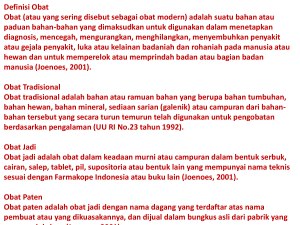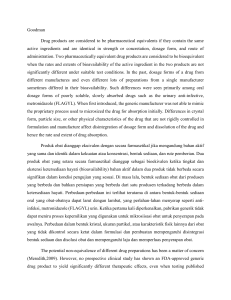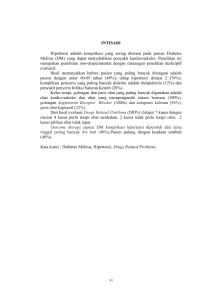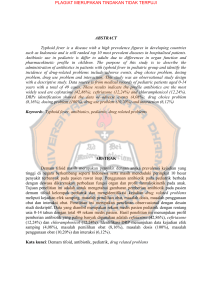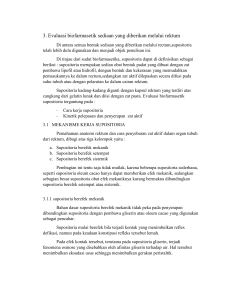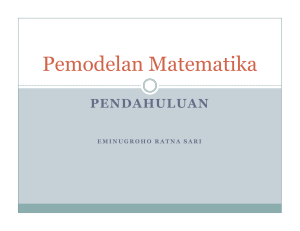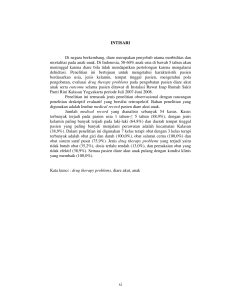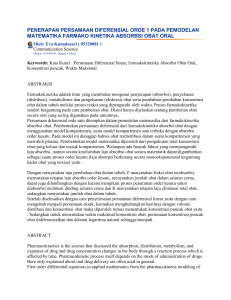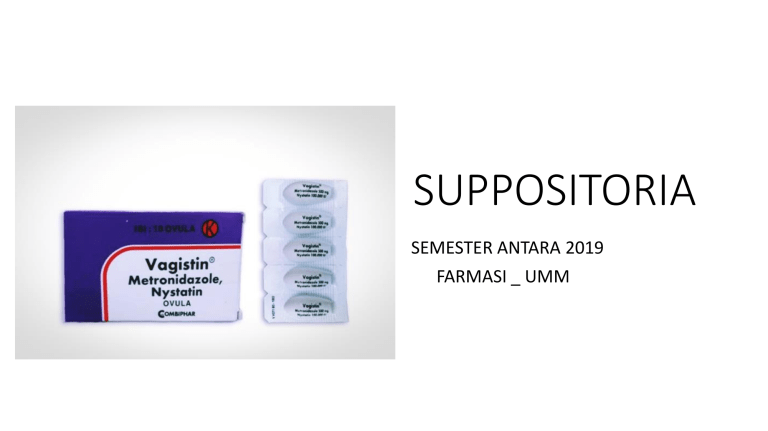
SUPPOSITORIA SEMESTER ANTARA 2019 FARMASI _ UMM Tujuan Pembelajaran: • Mahasiswa dapat menjelaskan pengertian sediaan supositoria. • Mahasiswa dapat menyebutkan jenis basis supositoria. • Mahasiswa dapat menjelaskan keuntungan sediaan supositoria. • Mahasiswa dapat menjelaskan kelemahan sediaan supositoria. • Mahasiswa dapat menjelaskan pembuatan sediaan supositoria skala apotek. • Mahasiswa dapat menjelaskan etiket/labeling sediaan supositoria. Definisi: (FI V) • Supositoria adalah sediaan padat dalam berbagai bobot dan bentuk, yang diberikan melalui rektal, vagina atau uretra. Umumnya meleleh, melunak atau melarut pada suhu tubuh. Supositoria dapat bertindak sebagai pelindung jaringan setempat, sebagai pembawa zat terapetik yang bersifat lokal atau sistemik. Bahan Dasar / Basis Bahan dasar supositoria yang umum digunakan adalah: lemak coklat, gelatin tergliserinasi, minyak nabati terhidrogenasi, campuran polietilen glikol berbagai bobot molekul dan ester asam lemak polietilenglikol • Bahan dasar supositoria yang digunakan sangat berpengaruh pada pelepasan zat terapetik. • Lemak coklat cepat meleleh pada suhu tubuh dan tidak tercampurkan dengan cairan tubuh, oleh karena itu menghambat difusi obat yang larut dalam lemak pada tempat yang diobati. • Polietilen glikol adalah bahan dasar yang sesuai untuk beberapa antiseptik. • Suatu bahan obat jika diharapkan bekerja secara sistemik, lebih baik menggunakan bentuk ionik dari pada nonionik, agar diperoleh ketersediaan hayati yang maksimum. • Meskipun obat bentuk nonionik dapat dilepas dari bahan dasar yang dapat bercampur dengan air, seperti gelatin tergliserinasi dan polietilen glikol, bahan dasar ini cenderung sangat lambat larut sehingga menghambat pengelepasan. • Bahan pembawa berminyak seperti lemak coklat jarang digunakan dalam sediaan vagina, karena membentuk residu yang tidak dapat diserap, sedangkan gelatin tergliserinasi jarang digunakan melalui rektal karena disolusinya lambat. Lemak coklat dan penggantinya (lemak keras) lebih baik untuk menghilangkan iritasi, seperti pada sediaan untuk hemoroid internal. 1. Supositoria Lemak Coklat • Supositoria dengan bahan dasar lemak coklat dapat dibuat dengan mencampur bahan obat yang dihaluskan ke dalam minyak padat pada suhu kamar dan massa yang dihasilkan dibuat dalam bentuk sesuai, atau dibuat dengan minyak dalam keadaan lebur dan membiarkan suspensi yang dihasilkan menjadi dingin di dalam cetakan. • Sejumlah zat pengeras yang sesuai dapat ditambahkan untuk mencegah kecenderungan beberapa obat, (seperti kloralhidrat dan fenol) melunakkan bahan dasar. Yang penting, supositoria meleleh pada suhu tubuh. • Perkiraan bobot supositoria yang dibuat dengan lemak coklat, dijelaskan dibawah ini. • Supositoria yang dibuat dari bahan dasar lain, bobotnya bervariasi dan dan umumnya lebih berat dari pada bobot yang disebutkan dibawah ini. • Supositoria rektal Supsitoria rektal untuk dewasa berbentuk lonjong pada satu atau kedua ujungnya dan biasanya berbobot lebih kurang 2g. • Supositoria vaginal Umumnya berbentuk bulat atau bulat telur dan berbobot lebih kurang 5 g, dibuat dari zat pembawa yang larut dalam air atau yang dapat bercampur dalam air, seperti polietilen glikol atau gelatin tergliserinasi. • Supositoria dengan bahan dasar lemak coklat harus disimpan dalam wadah tertutup baik, sebaiknya pada suhu dibawah 30º (suhu kamar terkendali). 2. Pengganti Lemak Coklat • Supositoria dengan bahan dasar jenis lemak, dapat dibuat dari berbagai minyak nabati, seperti minyak kelapa atau minyak kelapa sawit yang dimodifikasi dengan esterifikasi, hidrogenasi dan fraksionasi dengan esterifikasi, hidrogenasi dan fraksionasi hingga diperoleh berbagai komposisi dan suhu lebur (misalnya: Minyak nabati terhidrogenasi dan Lemak padat). • Produk ini dapat dirancang sedemikian hingga dapat mengurangi terjadinya ketengikan. Selain itu sifat yang diinginkan seperti interval yang sempit antara suhu melebur dan suhu memadat dan jarak lebur juga dapat dirancang untuk penyesuaian berbagai formulasi dan keadaan iklim. 3. Supositoria Gelatin Tergliserinasi • Bahan obat dapat dicampur ke dalam bahan dasar gelatin tergliserinasi, dengan menambahkan sejumlah tertentu kepada bahan pembawa yang terdiri dari: • lebih kurang 70 bagian gliserin, • 20 bagian gelatin • dan 10 bagian air. • Supositoria ini harus disimpan dalam wadah tertutup rapat,sebaiknya pada suhu dibawah 35º. 4. Supositoria Dengan Bahan Dasar Polietilen glikol. • Beberapa kombinasi polietilen glikol mempunyai suhu lebur lebih tinggi dari suhu badan telah digunakan sebagai bahan dasar supositoria. Karena pelepasan dari bahan dasar lebih ditentukan oleh disolusi dari pada pelelehan, maka masalah dalam pembuatan dan penyimpanan jauh lebih sedikit dibanding masalah yang disebabkan oleh jenis pembawa yang melebur. • Tetapi polietilen glikol dengan kadar tinggi dan bobot molekul lebih tinggi dapat memperpanjang waktu disolusi sehingga menghambat pelepasan. • Pada etiket supositoria polietilen glikol harus tertera petujuk “Basahi dengan air sebelum digunakan”. Meskipun dapat disimpan tanpa pendinginan, supositoria ini harus dikemas dalam wadah tertutup rapat. Polyethylene glycol bases / Macrogol bases (Carbowaxes) • Tergantung dari berat molekulnya, terdapat perbedaan fisik: Macrogol 400 Macrogol 1000 Macrogol 1540 Macrogol 4000 Macrogol 6000 Water I 33 47 20 II 33 47 20 III 20 33 47 - IV 75 25 - • Dengan memilih kombinasi yang sesuai dapat dibuat basis supositoria sesuai karakteristik. 5. Supositoria Dengan Bahan Dasar Surfaktan. • Beberapa surfaktan nonionik dengan sifat kimia mendekati polietilen glikol dapat digunakan sebagai bahan pembawa supositoria. • Contoh surfaktan ini adalah ester asam lemak polioksietilen sorbitan dan polioksietilen stearat. Surfaktan ini dapat digunakan dalam bentuk tunggal atau kombinasi dengan supositoria lain untuk memperoleh rentang suhu lebur yang lebar dan konsistensi. • Salah satu keuntungan utama pembawa ini adalah dapat terdispersi dalam air. Tetapi harus hati-hati dalam penggunaan surfaktan, karena dapat meningkatkan kecepatan absorpsi obat atau dapat berinteraksi dengan molekul obat, yang menyebabkan penurunan aktivitas terapetik. 6. Supositoria kempa atau Supositoria sisipan • Supositoria vaginal dapat dibuat dengan cara mengempa massa serbuk menjadi bentuk yang sesuai. Dapat juga dengan cara pengkapsulan dalam gelatin lunak. The advantages of rectal administration include the following 1. First-pass effect: Avoiding, at least partially, the first-pass effect that may result in higher blood levels for those drugs subject to extensive first-pass metabolism upon oral administration. The advantages of rectal administration include the following 2. Drug stability: Avoiding the breakdown of certain drugs that are susceptible to gastric degradation. 3. Large dose drugs: Ability to administer somewhat larger doses of drugs than using oral administration. 4. Irritating drugs: Ability to administer drugs that may have an irritating effect on the oral or gastrointestinal mucosa when administered orally. 5. Unpleasant tasting or smelling drugs: Ability to administer unpleasant tasting or smelling drugs whose oral administration is limited. 6. In children, the rectal route is especially useful. An ill child may refuse oral medication and may fear injections. 7. In patients experiencing nausea and vomiting or when the patient is unconscious. 8. The presence of disease of the upper gastrointestinal tract that may interfere with drug absorption. 9. Objectionable taste or odor of a drug (especially important in children). 10. Achievement of a rapid drug effect systemically (as an alternate to injection) The disadvantages of suppositories and the reasons given for the infrequent use of suppositories include the following: 1. A perceived lack of flexibility regarding dosage of commercially available suppositories resulting in under use and a lack of availability. 2. If suppositories are made on demand, they may be expensive. 3. Suppositories as a dosage form are safe, but they exhibit variable effectiveness, depending upon many factors to be discussed later, including the pathology of the anorectal lesions. 4. Different formulations of a drug with a narrow therapeutic margin, such as aminophylline, cannot be interchanged without risk of toxicity. 5. The “bullet-shaped” suppository after insertion can leave the anorectal site and ascend to the rectosigmoid and descending colon. Hence, one may consider that suppositories with this shape possibly should not be used at bedtime. 6. Defecation may interrupt the absorption process of the drug; this may especially occur if the drug is irritating. 7. The absorbing surface area of the rectum is much smaller than that of the small intestine. 8. The fluid content of the rectum is much less than that of the small intestine, which may affect dissolution rate, etc. 9. There is the possibility of degradation of some drugs by the microflora present in the rectum. 10. The dose of a drug required for rectal administration may be greater than or less than the dose of the same drug given orally. This can be dependent upon such factors as the constitution and condition of the patient, the physicochemical nature of the drug, and its ability to traverse the physiologic barriers to absorption, and the nature of the suppository vehicle and its capacity to release the drug and make it available for absorption. 11. The dose of a drug required for rectal administration may be greater than or less than the dose of the same drug given orally. This can be dependent upon such factors as the constitution and condition of the patient, the physicochemical nature of the drug, and its ability to traverse the physiologic barriers to absorption, and the nature of the suppository vehicle and its capacity to release the drug and make it available for absorption. Density (Dose Replacement) Calculations for Suppositories • In preparation of suppositories, it is generally assumed that if the quantity of active drug is less than 100 mg, then the volume occupied by the powder is insignificant and need not be considered. • This is usually based on a 2-g suppository weight. • Obviously, if a suppository mold of less than 2 g is used, the powder volume may need to be considered. • The density factors of various bases and drugs need to be known to determine the proper weights of the ingredients to be used. • Density factors relative to cocoa butter have been determined. If the density factor of a base is not known, it is simply calculated as the ratio of the blank weight of the base and cocoa butter. • Three methods of calculating the quantity of base that the active medication will occupy and the quantities of ingredients required are illustrated here: 1. Dosage replacement factor, 2. Density factor, and 3. Occupied volume methods Determination of the dosage Replacement factor methods: f= (100 𝐸−𝐺 ) 𝐺 (𝑋) +1 E is the weight of the pure base suppositories G is the weight of suppositories with X% of the active ingredient Cocoa butter is arbitrarily assigned a value of 1 as the standard base EXAMPLE 1 • Prepare a suppository containing 100 mg of phenobarbital (f = 0.81) using cocoa butter as the base. • The weight of the pure cocoa butter suppository is 2.0 g. Because 100 mg of phenobarbital is to be contained in an approximately 2.0-g suppository, it will be about 5% phenobarbital. • What will be the total weight of each suppository? ( 100 2 − 𝐺 ) 0.81 = +1 ( 𝐺 5 ) G = 2.019 ( 200 − 100𝐺 ) 0.81 = +1 ( 𝐺 5 ) -0,19 = (200-100G)/5G 100G-0.95G = 200 99.05 G = 200 G = 200/99.05 = 2.019 Dosage replacement factor Balsam of peru Phenol Bismuth subgallate Procaine HCl Bismuth subnitrate Quinine HCl Boric acid Resorcin Camphor 0.83 0.9 0.37 0.8 0.33 0.83 0.67 0.71 1.49 Silver protein, mild Castor oil Spermaceti Chloral hydrate White or yellow wax Ichthammol Zinc oxide Phenobarbital 0.61 1.00 1.0 0.67 1.0 0.91 0.15–0.25 0.81 Determination of Density Factor methods 1. Determine the average blank weight, A, per mold using the suppository base of interest. 2. Weigh the quantity of suppository base necessary for 10 suppositories. 3. Weigh 1.0 g of medication. The weight of medication per suppository, B, is equal to 1 g/10 supp = 0.1 g/supp. 4. Melt the suppository base and incorporate the medication, mix, pour into molds, cool, trim, and remove from the molds. 5. Weigh the 10 suppositories and determine the average weight (C). 6. Determine the density factor as follows: • 𝐷𝑒𝑛𝑠𝑖𝑡𝑦 𝐹𝑎𝑐𝑡𝑜𝑟 = 𝐵 𝐴−𝐶+𝐵 A = average weight of blank B = weight of medication per suppository, and C = average weight of medicated suppository 7. Take the weight of the medication required for each suppository and divide by the density factor of the medication to find the replacement value of the suppository base. 8. Subtract this quantity from the blank suppository weight. 9. Multiply by the number of suppositories required to obtain the quantity of base required for the prescription. 10. Multiply the weight of drug per suppository by the number of suppositories required to obtain the quantity of active drug required for the prescription. Density Factor Alum 1.7 Morphine HCl 1.6 Aminophylline 1.1 Opium 1.4 Aspirin 1.3 Paraffin 1.0 Barbital 1.2 Peruvian balsam 1.1 Belladonna extract 1.3 Phenobarbital 1.2 Benzoic acid 1.5 Phenol 0.9 Bismuth carbonate 4.5 Potassium bromide 2.2 Bismuth salicylate 4.5 Potassium iodide 4.5 Bismuth subgallate 2.7 Procaine 1.2 Bismuth subnitrate 6.0 Quinine HCl 1.2 Boric acid 1.5 Resorcinol 1.4 Castor oil 1.0 Sodium bromide 2.3 Chloral hydrate 1.3 Spermaceti 1.0 Cocaine HCl 1.3 Sulfathiazole 1.6 Digitalis leaf 1.6 Tannic acid 1.6 Glycerin 1.6 White wax 1.0 Ichthammol 1.1 Witch hazel fluid extract 1.1 Iodoform 4.0 Zinc oxide 4.0 Menthol 0.7 Zinc sulfate 2.8 • EXAMPLE 2 • Prepare 12 acetaminophen 300 mg suppositories using cocoa butter. The average weight of the cocoa butter blank is 2 g, and the average weight of the medicated suppository is 1.8 g. Dencity Factor (DF)= 0.3 2−1.8+0.3 = 0.6 • From step 7 : (0.3 g)/0.6 = 0.5 (the replacement value of the base) From step 8 : 2.0 − 0.5 g = 1.5 g • From step 9 : 12 × 1.5 g = 18 g cocoa butter required • From step 10: 12 × 0.3 g = 3.6 g acetaminophen Determination of occupied volume method 1. Determine the average weight per mold (blank) using the designated base. 2. Weigh out enough base for 12 suppositories. 3. Divide the density of the active drug by the density of the base to obtain a ratio. 4. Divide the total weight of active drug required for the total number of suppositories by the ratio obtained in step 3. This will give the amount of base displaced by the active drug. 5. Subtract the amount obtained in step 4 from the total weight of the prescription (number of suppositories multiplied by the weight of the blanks) to obtain the weight of base required. 6. Multiply the weight of active drug per suppository times the number of suppositories to be prepared to obtain the quantity of active drug required. • EXAMPLE 3 • Prepare 10 suppositories, each containing 200 mg of a drug with a density of 3.0. The base has a density of 0.9, and a prepared blank weighs 2.0 g. Using the determination of occupied volume method, prepare the requested suppositories. • From step 1: The average weight per mold is 2.0 g. • From step 2: The quantity required for 10 suppositories is 2 × 10 g = 20 g. From step 3: The density ratio is 3.0/0.9 = 3.3. • From step 4: The amount of suppository base displaced by the active drug is 2.0 g/3.3 = 0.6 g. • From step 5: The weight of the base required is 20 − 0.6 g = 19.4 g. • From step 6: The quantity of active drug required is 0.2 × 10 g = 2.0 g. • The required weight of the base is 19.4 g, and the weight of the active drug is 2 g.
